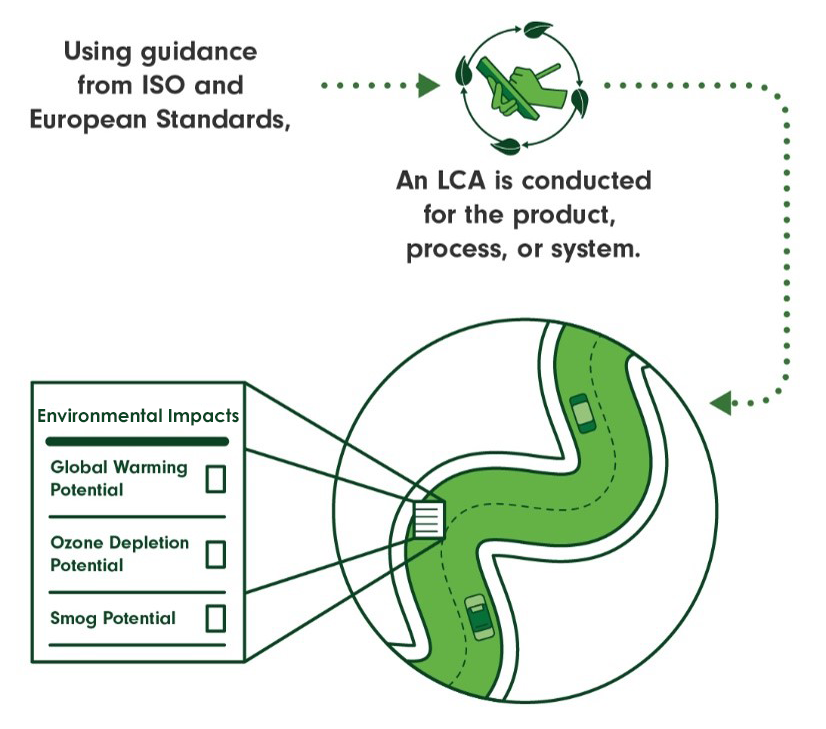Environmental Product Declarations (EPDs) for Sustainable Project Delivery
What are EPDs?

An EPD is a transparent, verified report of the environmental impacts of product manufacturing.
- Communicate environmental impacts of material or product
- Express the results of a life-cycle assessment (LCA)
- Developed with stakeholder input
- Follow industry specifications described in the Product Category Rule (PCR)
- EPDs and PCRs are not required by Federal law or regulation
EPD Concepts, Objectives, and Benefits

EPDs are product labels developed by industry in accordance with the International Organization for Standardization (ISO) Standard 14025 (ISO 2006). They are developed using LCA procedures and following the industry consensus methodology described in the governing PCR document. As specified in ISO 14025, EPDs undergo third-party verification before being published.
In the domain of pavements, EPDs are being developed for such construction materials as cement, aggregates, asphalt mixtures, concrete mixtures, and steel reinforcement. Based on ISO 14025 , EPDs are produced with the following objectives:
- Provide verifiable and transparent environmental impacts information for materials or products based on LCA
- Help purchasers to make more informed decisions
- Encourage industry efficiency and environmental improvement
- Support the supply and demand of products that produce less stress on environment
- Provide data for assessment of the products over their full life cycle.
The benefits of EPDs are:
- Sustainable Procurement. EPDs encourage the demand and supply of products that promote the more sustainable use of resources and create less stress on the environment.
- Sustainable Design. EPDs provide critical information for use in conceptual- and project-level full LCAs or other types of environmental assessment of alternative design decisions. EPDs allow for meaningful comparisons of environmental performance between materials fulfilling the same function.
- Sustainable Asset Management. EPD data can be included in databases used in asset management systems to perform network-level LCA and identify areas for environmental performance improvement.
Examples of How Agencies Can Use EPDs
- Agencies can request EPDs at material installation to establish benchmarks of current practices and develop performance metrics for the project.
- Agencies can leverage the use of EPDs to support the decision-making process throughout the project delivery process.
- EPDs can help agencies reduce greenhouse gas (GHG) emissions in their construction projects.
| ENVIRONMENTAL IMPACTS Declared Products: Description:Exterior 4000 PSI Compressive strength: 4000 PSI at 28 days Declared Unit: 1 m3 of concrete | |
|---|---|
| Global Warming Potential (kg CO -eq) | 318 |
| Ozone Depletion Potential (kg CFC-11-eq) | 7.15E-6 |
| Acidification Potential (kg SO -eq) | 0.95 |
| Eutrophication Potential (kg N-eq) | 0.24 |
| Photochemical Ozone Creation Potential (kg O -eq) | 20.7 |
| Abiotic Depletion, non-fossil (kg Sb-eq) | 5.82E-5 |
| Abiotic Depletion, fossil (MJ) | 658 |
| Total Waste Disposed (kg) | 94.2 |
| Consumption of Freshwater (m3) | 2.40 |
| Product Components: natural aggregate (ASTM C33), Portland cement (ASTM C150), fly ash (ASTM C618), batch water (ASTM C1602), admixture (ASTM C494), admixture (ASTM C260) | |
Sample information from Concrete EPD
| An Environmental Product Declaration for Asphalt Mixtures | ||
|---|---|---|
|
PRODUCT DESCRIPTION Gradation Type: dense Mix Design Method: superpave Nominal Maximum Aggregate Size: 12.5 mm Performance Grade of Asphalt Binder: PG 58-28 This mix producer categorizes this product as a Hot Mix Asphalt (HMA) asphalt mixture. This asphalt mixture was produced within a temperature range of 150 to 161°C |
||
| IMPACT CATEGORY | POTENTIAL IMPACT PER METRIC TONNE ASPHALT MIXTURE (PER TON ASPHALT MIXTURE) | |
| Global warming potential (GWP-100) | 71.05 (64.46) kg CO2 Equiv. | |
| Ozone depletion potential (ODP) | 9.92e-08 (9.00e-08) kg CFC-11 Equiv. | |
| Eutrophication potential (EP) | 1.24e-02 (1.13e-02) kg N Equiv. | |
| Acidification potential (AP) | 1.72e-01 (1.56e-01) kg SO2 Equiv. | |
| Photochemical ozone creation potential (POCP) | 4.51 (4.09) kg O3 Equiv. | |
| DECLARED UNIT: The declared unit is 1 metric tonne (1 short ton) of an asphalt mixture | ||
| PRODUCT INGREDIENTS | ||
| Component | Material | Weight % |
| Aggregate | Natural Stone | 15 |
| Aggregate | Natural Stone | 21 |
| Aggregate | Natural Stone | 13 |
| Aggregate | Natural Stone | 14 |
| Aggregate | Natural Stone | 8 |
| RAP | Reclaimed Asphalt Pavement | 24 |
| Binder | Unmodified | 4 |
Sample information from Asphalt EPD

